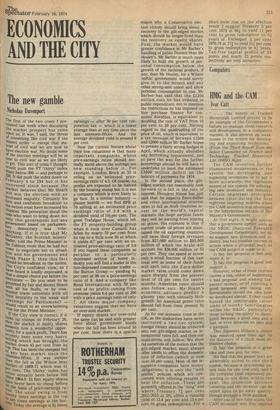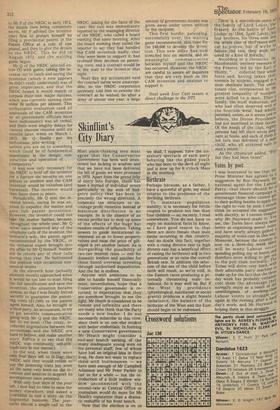Computers
HMG and the CAM
Ivor Catt
" . . . The history of Tracked Hovercraft Limited proved to be an example of the Government's failure to manage their research and development in a competent manner. It also showed up weaknesses in the system for developing and exploiting inventions." (From the Third Report from the Select Committee on Science and Technology, Tracked Hovercraft Ltd. HMSO 361p) The CAM invention further illuminated weaknesses in the system for developing and exploiting inventions, or to put it more accurately, the ingenious nature of the system for sabotaging new invention and industry. Certain important principles became clear during the first eighteen lingering months when the CAM invention was enveloped in the labyrinthine entrails of Her Majesty's Government.
At first sight, it might appear that a government agency such as the NRDC (National Research Development Corporation), set up to support new invention and industry, has two possible courses of action when a proposal such as the CAM project is made to it: 1) Say the proposal is bad and reject it, or 2) Say the proposal is good and support it. However, either of these courses carries a risk, either of supporting a bad proposal and wasting taxpayers' money, or of rejecting a good proposal and facing embarrassment should the idea later be developed abroad. Either could hazard the comfortable career paths of worthy functionaries within the NRDC, particularly those lacking the ability to distinguish between a good idea and a bad, or even between an idea and a apparent Hobson's choice gatepost. os t.
was resolved some time ago by the discovery of a third, most attractive choice: 3) Say the proposal is a great idea and then play for time.
We find that the patent laws are admirably suited to this third course, because a provisional patent lasts for one year only, and if the complete (and expensive) patenting is not done within the year, the invention becomes valueless and the inventor can be relied upon to go away quietly, though perhaps a little puzzled.
After one or two false starts, the CAM invention was first mooted
to Mr P of the NRDC in early 1972, the details then being completely secret. Mr P advised the inventor (me) first to protect himself by filing a provisional patent in the Patent Office at a cost of one pound, and then to give the details to the NRDC. This he did in August 1972, and the waiting game began.
Mr Q of the NRDC selected option (3) with gusto, taking the inventor out to lunch and saying the invention (which it now appears he didn't really understand) was of great importance, and that the NRDC hoped it would match or surpass their one major success, which was currently earning them some £4 million per annum. This enthusiastic evaluation (and all appraisals of the CAM invention by all government officials have been enthusiastic) was all verbal, and there were lengthy delays for various obscure reasons until six months later, when on March 1, 1973, Mr Q finally put his enthusiasm into writing: " . . . I believe you are on to something which could be of fundamental importance in the design, construction and operation of . . . (computers)." It was now only necessary for the NRDC to hold off the inventor for a further six months on one pretext or another and the CAM invention would be valueless (and harmless). The inventor would then leave them in peace.
Periodically, Mr Q sent the inventor letters, saying he was anxious to expedite the matter and gain full patent protection. However, the inventor could not take the matter further, because, throughout the whole year, Mr Q never once answered any of the telephone calls of the inventor, the inventor's wife, the patent agent recommended by the NRDC, or the technical expert brought into the affair by Mr Q himself. Neither did he return any of their calls during that year. He buttressed this position with occasional nonsensical letters.
As the eleventh hour (actually eleventh month) approached when it would be too late to start filing the full specification and save the invention, the situation became serious, so that I was finally forced secretly to guarantee the patenting costs (£1,700) to the patent agent himself. Also, he brought in a third party, an accountant, to try to get sensible communication going with Mr Q and the NRDC, but to no avail. (The crazy, incoherent negotiations between the accountant and the NRDC are hard to believe, and make another story. Suffice it to say that the NRDC was continually self-contradictory in the matter.)
In the end, when there were only four days left to D-Day, the NRDC said they would refuse to pay the patenting costs but were all the same very keen on the invention and anxious to support its development once patented. With only four days of the year
left, I now had no time to raise the money elsewhere, and asked a Journalist to run a story on the
disgraceful business. The journalist placed a single call to the NRDC, asking for the facts of the case. His call was immediately reported to the managing director of the NRDC, who called a board meeting that same morning. After the board meeting they called the reporter to say they had handled the CAM invention badly, that they were keen to support it, had reversed their decision on patenting costs, and a contract would be in the mail to the inventor that night.
Next day my accountant said the contract terms were unacceptable, so the NRDC corporation secretary told him to rewrite the contract as he wished. So after a delay of almost one year, a large



































 Previous page
Previous page